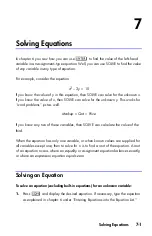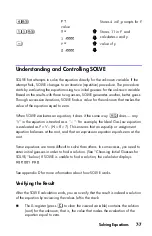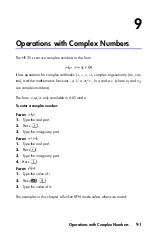
7-9
These sources are used for guesses
whether you enter guesses or not
. If you enter
only one guess and store it in the variable, the second guess will be the same value
since the display also holds the number you just stored in the variable. (If such is the
case, the calculator changes one guess slightly so that it has two different guesses.)
Entering your own guesses has the following advantages:
By narrowing the range of search, guesses can reduce the time to find a
solution.
If there is more than one mathematical solution, guesses can direct the SOLVE
procedure to the desired answer or range of answers. For example, the
equation of linear motion
d
= v
0
t +
1
/
2
gt
2
can have two solutions for
t
. You can direct the answer to the required
solution by entering appropriate guesses.
T
he example using this equation earlier in this chapter didn't require you to
enter guesses before solving for
T
because in the first part of that example you
stored a value for
T
and solved for
D.
The value that was left in
T
was a good
(realistic) one, so it was used as a guess when solving for
T
.
If an equation does not allow certain values for the unknown, guesses can
prevent these values from occurring. For example,
y
=
t
+ log
x
results in an error if
x
≤
0 (message
).
In the following example, the equation has more than one root, but guesses help
find the desired root.
Summary of Contents for 35s
Page 1: ...HP 35s scientific calculator user s guide H Edition 1 HP part number F2215AA 90001 ...
Page 14: ...12 Contents ...
Page 15: ...Part 1 Basic Operation ...
Page 16: ......
Page 46: ...1 30 Getting Started ...
Page 63: ...RPN The Automatic Memory Stack 2 17 A Solution ...
Page 64: ...2 18 RPN The Automatic Memory Stack ...
Page 74: ...3 10 Storing Data into Variables ...
Page 180: ...12 14 Statistical Operations ...
Page 181: ...Part 2 Programming ...
Page 182: ......
Page 246: ...15 12 Solving and Integrating Programs ...
Page 270: ...16 24 Statistics Programs ...
Page 284: ...17 14 Miscellaneous Programs and Equations ...
Page 285: ...Part 3 Appendixes and Reference ...
Page 286: ......
Page 308: ...B 8 User Memory and the Stack ...
Page 322: ...C 14 ALG Summary ...
Page 336: ...D 14 More about Solving ...
Page 346: ...E 10 More about Integration ...
Page 352: ...F 6 Messages ...
Page 370: ...G 18 Operation Index ...
Page 382: ...Index 12 ...















































